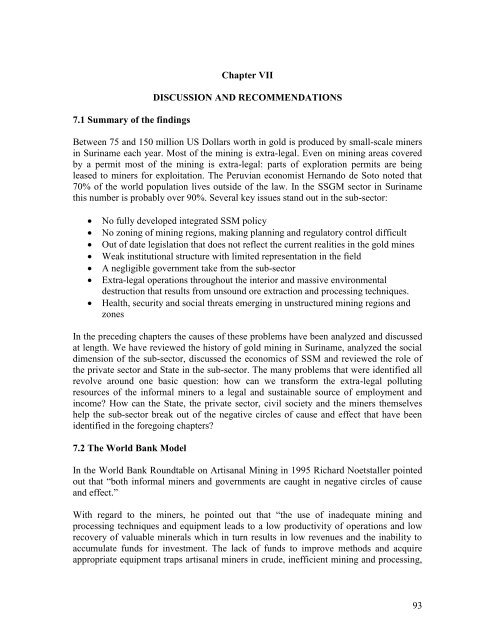SITUATION ANALYSIS OF THE SMALL-SCALE GOLD ... - WWF
SITUATION ANALYSIS OF THE SMALL-SCALE GOLD ... - WWF
SITUATION ANALYSIS OF THE SMALL-SCALE GOLD ... - WWF
Create successful ePaper yourself
Turn your PDF publications into a flip-book with our unique Google optimized e-Paper software.
7.1 Summary of the findings<br />
Chapter VII<br />
DISCUSSION AND RECOMMENDATIONS<br />
Between 75 and 150 million US Dollars worth in gold is produced by small-scale miners<br />
in Suriname each year. Most of the mining is extra-legal. Even on mining areas covered<br />
by a permit most of the mining is extra-legal: parts of exploration permits are being<br />
leased to miners for exploitation. The Peruvian economist Hernando de Soto noted that<br />
70% of the world population lives outside of the law. In the SSGM sector in Suriname<br />
this number is probably over 90%. Several key issues stand out in the sub-sector:<br />
No fully developed integrated SSM policy<br />
No zoning of mining regions, making planning and regulatory control difficult<br />
Out of date legislation that does not reflect the current realities in the gold mines<br />
Weak institutional structure with limited representation in the field<br />
A negligible government take from the sub-sector<br />
Extra-legal operations throughout the interior and massive environmental<br />
destruction that results from unsound ore extraction and processing techniques.<br />
Health, security and social threats emerging in unstructured mining regions and<br />
zones<br />
In the preceding chapters the causes of these problems have been analyzed and discussed<br />
at length. We have reviewed the history of gold mining in Suriname, analyzed the social<br />
dimension of the sub-sector, discussed the economics of SSM and reviewed the role of<br />
the private sector and State in the sub-sector. The many problems that were identified all<br />
revolve around one basic question: how can we transform the extra-legal polluting<br />
resources of the informal miners to a legal and sustainable source of employment and<br />
income? How can the State, the private sector, civil society and the miners themselves<br />
help the sub-sector break out of the negative circles of cause and effect that have been<br />
identified in the foregoing chapters?<br />
7.2 The World Bank Model<br />
In the World Bank Roundtable on Artisanal Mining in 1995 Richard Noetstaller pointed<br />
out that “both informal miners and governments are caught in negative circles of cause<br />
and effect.”<br />
With regard to the miners, he pointed out that “the use of inadequate mining and<br />
processing techniques and equipment leads to a low productivity of operations and low<br />
recovery of valuable minerals which in turn results in low revenues and the inability to<br />
accumulate funds for investment. The lack of funds to improve methods and acquire<br />
appropriate equipment traps artisanal miners in crude, inefficient mining and processing,<br />
93
















